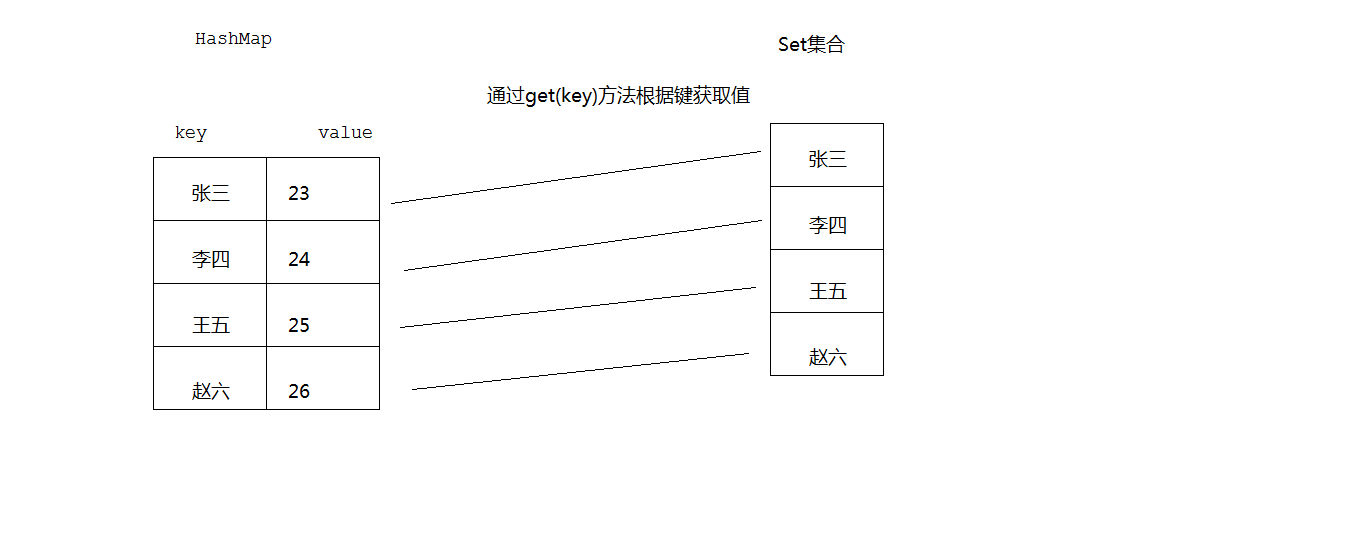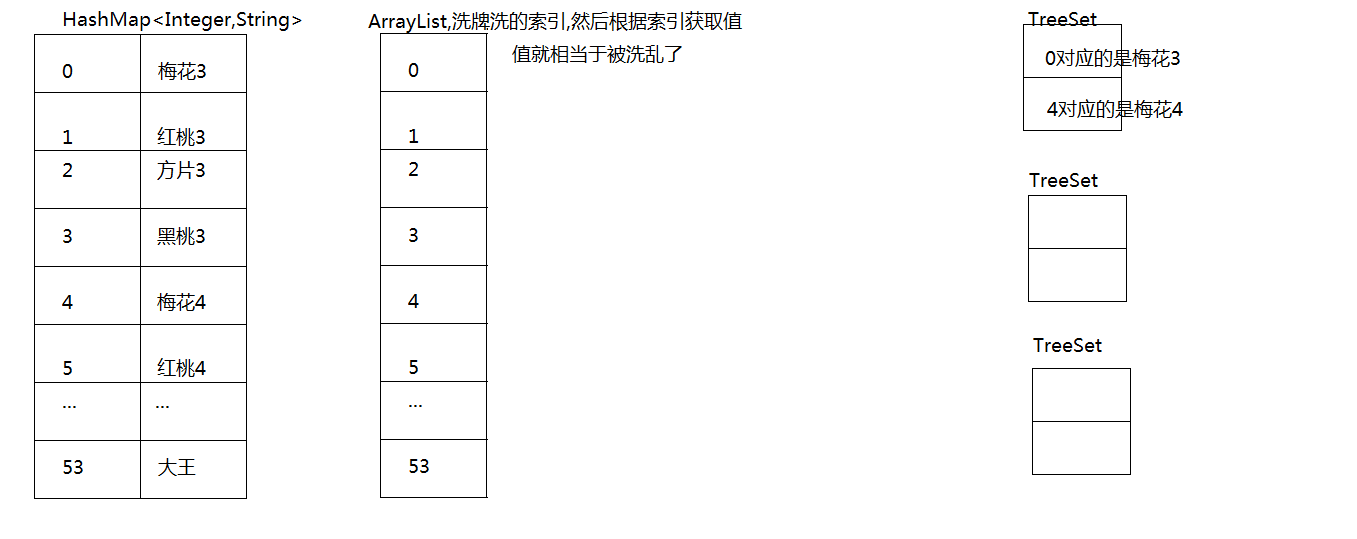18.01_集合框架(Map集合概述和特点)
- A:Map接口概述
- 查看API可以知道:
- 将键映射到值的对象
- 一个映射不能包含重复的键
- 每个键最多只能映射到一个值
- 查看API可以知道:
- B:Map接口和Collection接口的不同
- Map是双列的,Collection是单列的(HashSet底层依赖HashMap,两个共用一套Hash算法)
- Map的键唯一,Collection的子体系Set是唯一的
- Map集合的数据结构值针对键有效,跟值无关;Collection集合的数据结构是针对元素有效
18.02_集合框架(Map集合的功能概述)
- A:Map集合的功能概述
- a:添加功能
- V put(K key,V value):添加元素。
- 如果键是第一次存储,就直接存储元素,返回null
- 如果键不是第一次存在,就用值把以前的值替换掉,返回以前的值(被覆盖的值)
- V put(K key,V value):添加元素。
- b:删除功能
- void clear():移除所有的键值对元素
- V remove(Object key):根据键删除键值对元素,并把值返回
- c:判断功能
- boolean containsKey(Object key):判断集合是否包含指定的键
- boolean containsValue(Object value):判断集合是否包含指定的值
- boolean isEmpty():判断集合是否为空
- d:获取功能
- Set
- a:添加功能
/**
* Map添加:
* 1. 不能重复,存取顺序不一致
* 2. 若键不存在,指直接存储,返回null;若键已经存在,则替换原来的值,返回被替换的值
* @param args
*/
public static void main(String[] args) {
// TODO Auto-generated method stub
Map<String, Integer> map = new HashMap();
//添加
Integer i1 = map.put("张三", 23); //null //若键不存在,指直接存储,返回null
Integer i2 = map.put("李四", 24); //null //若键已经存在,则替换原来的值,返回被替换的值
Integer i3 = map.put("王五", 25); //null
Integer i4 = map.put("赵六", 26); //null
Integer i5 = map.put("张三", 27); //23
System.out.println(map); //{李四=24, 张三=27, 王五=25, 赵六=26}
//删除
Integer value = map.remove("张三"); //根据键删除元素,返回键对应的值
System.out.println(value);//27
System.out.println(map);//{李四=24, 王五=25, 赵六=26}
//map.clear(); //清空
//判断
System.out.println(map.containsKey("张三")); //false //判断是否包含键
System.out.println(map.containsValue(24)); //true //判断是否包含值
System.out.println(map.isEmpty()); //false //判断是否为空
//获取
Set<String> s = map.keySet(); //获取集合中所有键的集合
System.out.println(s); //[李四, 王五, 赵六]
Collection<Integer> c = map.values(); //获取集合中所有值的集合
System.out.println(map.size()); //返回Map集合中键值对的个数
}
18.03_集合框架(Map集合的遍历之键找值)
- A:键找值思路:
- 获取所有键的集合
- 遍历键的集合,获取到每一个键
- 根据键找值
B:案例演示
Map集合的遍历之键找值
HashMap<String, Integer> hm = new HashMap<>(); hm.put("张三", 23); hm.put("李四", 24); hm.put("王五", 25); hm.put("赵六", 26); /*Set<String> keySet = hm.keySet(); //获取集合中所有的键 Iterator<String> it = keySet.iterator(); //获取迭代器 while(it.hasNext()) { //判断单列集合中是否有元素 String key = it.next(); //获取集合中的每一个元素,其实就是双列集合中的键 Integer value = hm.get(key); //根据键获取值 System.out.println(key + "=" + value); //打印键值对 }*/ for(String key : hm.keySet()) { //增强for循环迭代双列集合第一种方式 System.out.println(key + "=" + hm.get(key)); }
18.04_集合框架(Map集合的遍历之键值对对象找键和值)
- A:键值对对象找键和值思路:
- 获取所有键值对对象的集合
- 遍历键值对对象的集合,获取到每一个键值对对象
- 根据键值对对象找键和值
- Map.Entry说明Entry是Map的内部接口,将键和值封装成了Entry对象,并存储在Set集合中
- 获取到Entry对象后,通过getKey()、getValue()获取键和值
B:案例演示
Map集合的遍历之键值对对象找键和值
HashMap<String, Integer> hm = new HashMap<>(); hm.put("张三", 23); hm.put("李四", 24); hm.put("王五", 25); hm.put("赵六", 26); /*Set<Map.Entry<String, Integer>> entrySet = hm.entrySet(); //获取所有的键值对象的集合 Iterator<Entry<String, Integer>> it = entrySet.iterator();//获取迭代器 while(it.hasNext()) { Entry<String, Integer> en = it.next(); //获取键值对对象 String key = en.getKey(); //根据键值对对象获取键 Integer value = en.getValue(); //根据键值对对象获取值 System.out.println(key + "=" + value); }*/ for(Entry<String,Integer> en : hm.entrySet()) { System.out.println(en.getKey() + "=" + en.getValue()); } //这里直接写Entry也行,相当于直接使用子类对象;要是写Map.Entry相当于父类引用指向子类对象.
C:源码分析
总结:遍历的两种方式(增强for)
HashMap<Character, Integer> hm = new HashMap<Character, Integer>();
//遍历1:
for(Character key : hm.keySet()){
System.out.println(key+"..."+hm.get(key));
}
System.out.println("-------------");
//遍历2:
for(Entry<Character, Integer> en:hm.entrySet()){
System.out.println(en.getKey()+"..."+en.getValue());
}18.05_集合框架(HashMap集合键是Student ,值是String的案例)
- A:案例演示
- HashMap集合键是Student,值是String的案例
- 主要看如何保证键的唯一
- 和HashSet原理一样,要重写HashCode()和equals()方法
/**
* HashMap集合键是Student,值是String的案例
* @param args
*/
public static void main(String[] args) {
// TODO Auto-generated method stub
HashMap<Student, String> hm = new HashMap<>();
hm.put(new Student("张三",23),"北京");
hm.put(new Student("赵四",24),"上海");
hm.put(new Student("王五",25),"杭州");
hm.put(new Student("赵六",26),"衡水");
hm.put(new Student("张三",23),"武强");
System.out.println(hm);
//结果:{Student [name=张三, age=23]=武强, Student [name=赵四, age=24]=上海, Student [name=赵六, age=26]=衡水, Student [name=王五, age=25]=杭州}
}//Student重写HashCode()和equals()方法,自动生成即可
@Override
public int hashCode() {
final int prime = 31;
int result = 1;
result = prime * result + age;
result = prime * result + ((name == null) ? 0 : name.hashCode());
return result;
}
@Override
public boolean equals(Object obj) {
if (this == obj)
return true;
if (obj == null)
return false;
if (getClass() != obj.getClass())
return false;
Student other = (Student) obj;
if (age != other.age)
return false;
if (name == null) {
if (other.name != null)
return false;
} else if (!name.equals(other.name))
return false;
return true;
}18.06_集合框架(LinkedHashMap的概述和使用)
- A:案例演示
- LinkedHashMap的特点
- 底层是链表实现的可以保证怎么存就怎么取
- LinkedHashMap的特点
18.07_集合框架(TreeMap集合键是Student值是String的案例)
- A:案例演示
- TreeMap集合键是Student值是String的案例
- 同TreeSet一样,要实现Comparable接口,实现CompareTo()。或者使用内部类方式 创建Comparator类对象,实现compare()方法。
法一:
/**
* TreeMap集合键是Student值是String的案例
* @param args
*/
public static void main(String[] args) {
// TODO Auto-generated method stub
TreeMap<Student, String> tm = new TreeMap<Student, String>();
tm.put(new Student("张三",33),"北京");
tm.put(new Student("李四",13),"上海");
tm.put(new Student("王五",43),"杭州");
tm.put(new Student("赵六",23),"衡水");
System.out.println(tm);
}
public class Student implements Comparable<Student>{
private String name;
private int age;
。。。
@Override
@Override
public int compareTo(Student o) {
int num = this.age - o.age; //以年龄为主要条件
return num==0? this.name.compareTo(o.name):num;//以名字为次要条件
}
}法二:
/**
* TreeMap集合键是Student值是String的案例
* @param args
*/
public static void main(String[] args) {
// TODO Auto-generated method stub
//Demo1();
TreeMap<Student, String> tm = new TreeMap<Student, String>(new Comparator<Student>(){
@Override
public int compare(Student s1, Student s2) {
int num = s1.getName().compareTo(s2.getName()); //以名字为主要条件
return num ==0 ? s1.getAge() - s2.getAge() : num; //以年龄为次要条件
}
});
tm.put(new Student("张三",33),"北京");
tm.put(new Student("赵四",13),"上海");
tm.put(new Student("王五",43),"杭州");
tm.put(new Student("赵六",23),"衡水");
System.out.println(tm);
}
private static void Demo1() {
TreeMap<Student, String> tm = new TreeMap<Student, String>();
tm.put(new Student("张三",33),"北京");
tm.put(new Student("赵四",13),"上海");
tm.put(new Student("王五",43),"杭州");
tm.put(new Student("赵六",23),"衡水");
System.out.println(tm);
}18.08_集合框架(统计字符串中每个字符出现的次数)
- A:案例演示
- 需求:统计字符串中每个字符出现的次数
/**
* 需求:统计字符串中每个字符出现的次数
* @param args
*/
public static void main(String[] args) {
// TODO Auto-generated method stub
String s = "aasdsdasdfsdfe";
HashMap<Character, Integer> hm = new HashMap<Character, Integer>();
char[] arr = s.toCharArray();
for(char c : arr){
/*if(!hm.containsKey(c)){
hm.put(c, 1);
}else{
hm.put(c, hm.get(c)+1);
}*/
hm.put(c, !hm.containsKey(c)?1:hm.get(c)+1);
}
for(Character key : hm.keySet()){
System.out.println(key+"..."+hm.get(key));
}
System.out.println("-------------");
for(Entry<Character, Integer> en:hm.entrySet()){
System.out.println(en.getKey()+"..."+en.getValue());
}
}18.09_集合框架(集合嵌套之HashMap嵌套HashMap)
- A:案例演示
- 集合嵌套之HashMap嵌套HashMap
18.10_集合框架(HashMap和Hashtable的区别)
A:面试题
HashMap和Hashtable的区别
- Hashtable是JDK1.0版本出现的,是线程安全的,效率低,
HashMap是JDK1.2版本出现的,是线程不安全的,效率高
Hashtable不可以存储null键和null值,
- HashMap可以存储null键和null值
- B:案例演示
- HashMap和Hashtable的区别
18.11_集合框架(Collections工具类的概述和常见方法讲解)
- A:Collections类概述
- 针对集合操作 的工具类
- B:Collections成员方法
public static <T> void sort(List<T> list)
public static <T> int binarySearch(List<?> list,T key)
public static <T> T max(Collection<?> coll)
public static void reverse(List<?> list)
public static void shuffle(List<?> list) public static void main(String[] args){
ArrayList<String> list = new ArrayList<>();
list.add("c");
list.add("a");
list.add("g");
list.add("e");
Collections.sort(list); //1.对集合进行排序
System.out.println(list); //[a, c, e, g]
//2.二分查找(针对有序排列),若找到返回索引;若没有找到,返回-(插入的位置)-1。
//在进行此调用之前,必须根据列表元素的自然顺序对列表进行升序排序(通过 sort(List) 方法)。
//如果没有对列表进行排序,则结果是不确定的。如果列表包含多个等于指定对象的元素,则无法保证找到的是哪一个。
System.out.println(Collections.binarySearch(list, "b"));//-2
System.out.println(Collections.binarySearch(list, "c"));//1
//3.最大值、最小值
System.out.println(Collections.max(list));//g
System.out.println(Collections.min(list));//a
//4.反转
Collections.reverse(list);
System.out.println(list);//[g, e, c, a]
//5.随机排序,可以用来洗牌
Collections.shuffle(list);
System.out.println(list);
}18.12_集合框架(模拟斗地主洗牌和发牌)
A:案例演示
模拟斗地主洗牌和发牌,牌没有排序
//买一副扑克 String[] num = {"A","2","3","4","5","6","7","8","9","10","J","Q","K"}; String[] color = {"方片","梅花","红桃","黑桃"}; ArrayList<String> poker = new ArrayList<>(); for(String s1 : color) { for(String s2 : num) { poker.add(s1.concat(s2)); } } poker.add("小王"); poker.add("大王"); //洗牌 Collections.shuffle(poker); //发牌 ArrayList<String> gaojin = new ArrayList<>(); ArrayList<String> longwu = new ArrayList<>(); ArrayList<String> me = new ArrayList<>(); ArrayList<String> dipai = new ArrayList<>(); for(int i = 0; i < poker.size(); i++) { if(i >= poker.size() - 3) { dipai.add(poker.get(i)); }else if(i % 3 == 0) { gaojin.add(poker.get(i)); }else if(i % 3 == 1) { longwu.add(poker.get(i)); }else { me.add(poker.get(i)); } } //看牌 System.out.println(gaojin); System.out.println(longwu); System.out.println(me); System.out.println(dipai);
18.13_集合框架(模拟斗地主洗牌和发牌并对牌进行排序的原理图解)
- A:画图演示
- 画图说明排序原理
- 画图说明排序原理
18.14_集合框架(模拟斗地主洗牌和发牌并对牌进行排序的代码实现)
- A:案例演示
- 模拟斗地主洗牌和发牌并对牌进行排序的代码实现
//买一副牌 String[] num = {"3","4","5","6","7","8","9","10","J","Q","K","A","2"}; String[] color = {"方片","梅花","红桃","黑桃"}; HashMap<Integer, String> hm = new HashMap<>(); //存储索引和扑克牌 ArrayList<Integer> list = new ArrayList<>(); //存储索引 int index = 0; //索引的开始值 for(String s1 : num) { for(String s2 : color) { hm.put(index, s2.concat(s1)); //将索引和扑克牌添加到HashMap中 list.add(index); //将索引添加到ArrayList集合中 index++; } } hm.put(index, "小王"); list.add(index); index++; hm.put(index, "大王"); list.add(index); //洗牌 Collections.shuffle(list); //发牌 TreeSet<Integer> gaojin = new TreeSet<>(); TreeSet<Integer> longwu = new TreeSet<>(); TreeSet<Integer> me = new TreeSet<>(); TreeSet<Integer> dipai = new TreeSet<>(); for(int i = 0; i < list.size(); i++) { if(i >= list.size() - 3) { dipai.add(list.get(i)); //将list集合中的索引添加到TreeSet集合中会自动排序 }else if(i % 3 == 0) { gaojin.add(list.get(i)); }else if(i % 3 == 1) { longwu.add(list.get(i)); }else { me.add(list.get(i)); } } //看牌 lookPoker("高进", gaojin, hm); lookPoker("龙五", longwu, hm); lookPoker("冯佳", me, hm); lookPoker("底牌", dipai, hm); } public static void lookPoker(String name,TreeSet<Integer> ts,HashMap<Integer, String> hm) { System.out.print(name + "的牌是:"); for (Integer index : ts) { System.out.print(hm.get(index) + " "); } System.out.println(); }
18.15_集合框架(泛型固定下边界)
- ? super E
public class Demo2_genric {
/**
* ? super E 泛型固定下边界,,比如Student的比较器,BaseStudent也可以用(拿出来比较)
* ? extends E 泛型固定上边界,,比如BaseStudent加入到Student中(放进去)
* @param args
*/
public static void main(String[] args) {
//addAll(Collection<? extends E> c)
ArrayList<Student> list1 = new ArrayList<Student>();
list1.add(new Student("a",23));
list1.add(new Student("b",45));
ArrayList<BaseStudent> list2 = new ArrayList<>();
list2.add(new BaseStudent("a",23));
list2.add(new BaseStudent("b",45));
list1.addAll(list2);
//TreeMap(Comparator<? super K> comparator)
TreeSet<Student> ts = new TreeSet<>(new CompareByAge());
ts.add(new Student("a",23));
ts.add(new Student("b",45));
ts.add(new Student("c",25));
TreeSet<BaseStudent> ts1 = new TreeSet<>(new CompareByAge());
ts1.add(new BaseStudent("a",23));
ts1.add(new BaseStudent("b",45));
ts1.add(new BaseStudent("c",25));
System.out.println(ts1);
//在这里,比较器是Student的,但是BaseStudent也能用
}
}
class CompareByAge implements Comparator<Student>{
@Override
public int compare(Student s1, Student s2) {
int num = s1.getAge() -s2.getAge();
return num==0?s1.getName().compareTo(s2.getName()):num;
}
}18.16_day18总结
- 把今天的知识点总结一遍。

























 478
478

 被折叠的 条评论
为什么被折叠?
被折叠的 条评论
为什么被折叠?








